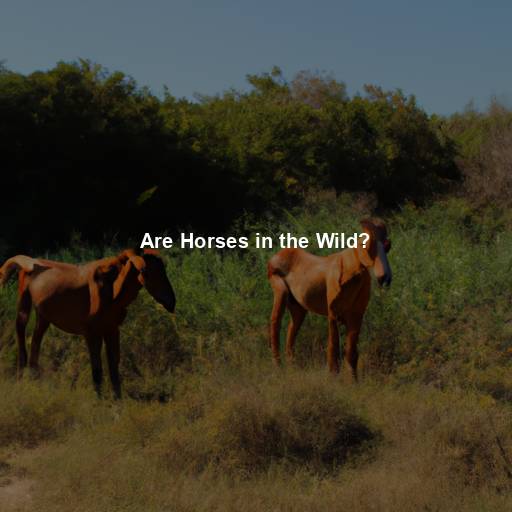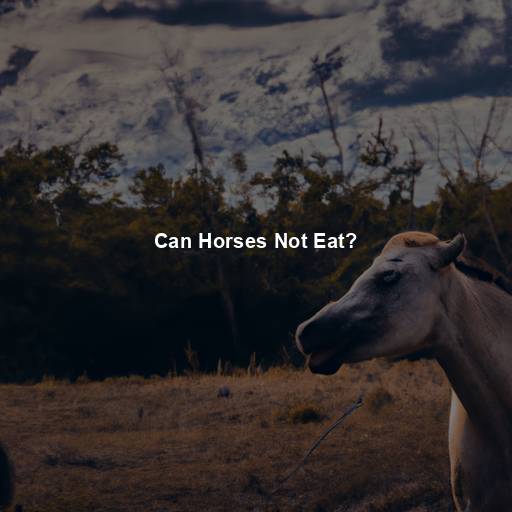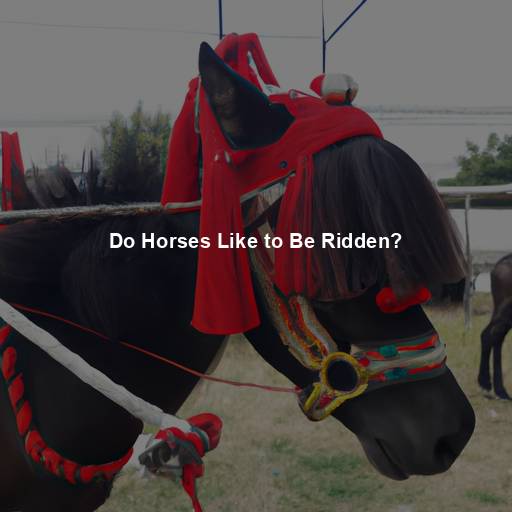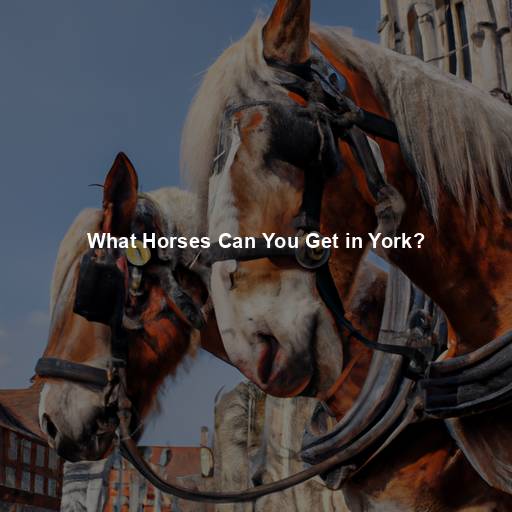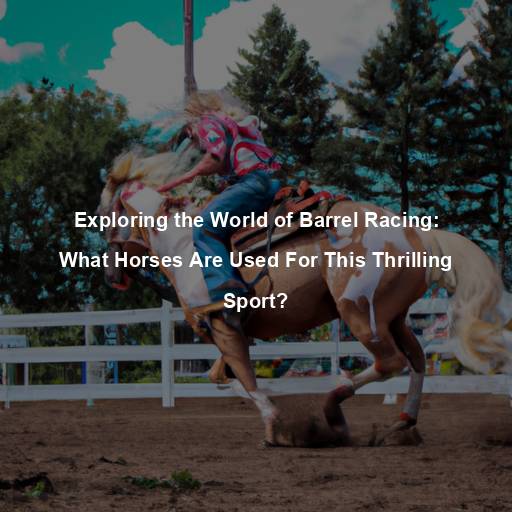Are Horses in the Wild?
Last Updated on November 6, 2023 by Evan
Horses have long captivated the human imagination with their grace, power, and beauty. From the wild mustangs roaming the vast plains to the majestic horses of fairy tales and legends, these magnificent creatures have become an integral part of our cultural heritage. But have you ever wondered if horses are truly found in the wild? In this article, we will explore the origins of horses, their natural habitats, and the impact of human intervention on their existence.
Contents [hide]
The Evolution of Horses
To understand the presence of horses in the wild, we must delve into their evolutionary history. Horses, scientifically known as Equus ferus caballus, belong to the family Equidae, which also includes zebras and donkeys. Their ancestors were small, dog-sized mammals that lived over 50 million years ago.
The Dawn Horse
Have you ever wondered about the mysterious origins of the magnificent horses that roam our lands today? Delve into the enigmatic past and discover the captivating tale of the “dawn horse,” also known as Hyracotherium. Imagine a world where these herbivorous creatures with multiple toes on each foot roamed lush forests, their presence shrouded in fascination and wonder. Through the unfathomable course of millions of years, witness the perplexing evolution that transformed these remarkable beings into the graceful, single-toed equine champions we admire galloping across vast open grasslands.
Wild Horses of the Past
During the Ice Age, wild horses roamed across various parts of the world, including Europe, Asia, and North America. These horses adapted to survive in diverse environments, from the frigid tundra to the arid deserts. The Przewalski’s horse, also known as the Mongolian wild horse, is considered the only surviving truly wild horse species in the world today.
The Impact of Human Intervention
Throughout history, humans have exerted a profound influence on the fate of wild horse populations and their natural habitats. From the ancient process of domestication that commenced around 4000 BCE, to contemporary efforts aimed at conservation and preservation, the intricate relationship between humans and horses has been both a blessing and a curse for these majestic creatures. As we delve into the perplexing world of equine existence, it becomes clear that our actions have played a pivotal role in shaping the destiny of these enchanting animals. Whether through encroachment upon their habitats or selective breeding, the once abundant wild horse population now faces a more uncertain future, at the mercy of human behavior and shifting societal values.
Domestication and Feral Horses
From prehistoric times to the modern era, the close and complex relationship between humans and horses has rewritten the narrative of civilization itself. Ancient scribes chronicled the watershed moment when horses became companions in journeys across vast landscapes, pivotal tools for taming nature’s wild frontiers. Yet, as the wheels of time turn, the mystical bond occasionally unravels, leaving behind a perplexing phenomenon – the birth of feral horses. These enigmatic creatures, untamed and unrestrained, defy our understanding as they traverse rugged terrains, defying the impossibilities of survival without the shackles of human intervention.
The American Mustangs
One famous example of feral horses is the American mustang. Descendants of Spanish horses brought to the Americas by European explorers, mustangs have become iconic symbols of the American West. These horses roam freely in designated areas such as national parks and public lands, reflecting a glimpse of their wild ancestors.
Conservation Efforts
In today’s world, where the need to safeguard our natural heritage is more pressing than ever, it is heartening to witness the unwavering commitment of various conservation organizations towards the protection and management of our esteemed wild horse populations. With a tireless determination to strike a harmonious equilibrium between the preservation of thriving ecosystems and the longevity of these majestic creatures, these initiatives embody the intricate dance between mankind and nature. They serve as a testament to our collective responsibility in nurturing and cherishing the delicate wonders that adorn our vast wilderness.
The Modern-Day Habitat of Horses
Discover the captivating world where equine grace intertwines with untamed spirit as we embark on a journey through the unique domains of semi-wild and feral horse populations. From the rugged landscapes of North America to the windswept plains of Australia, these magnificent creatures thrive in a state of paradoxical harmony, enchanting us with their resilience and captivating beauty. Join us as we delve into the perplexing allure of these creatures, unearthing the astonishing stories behind their existence in a world that continues to perplex and awe.
Mongolian Steppe
The magnificent expanse of the Mongolian Steppe is an enigmatic realm that shrouds a captivating secret—the Przewalski’s horse, a resilient symbol of untamed wilderness. Dwelling in this unforgiving terrain, these majestic creatures have evolved remarkable survival skills to embrace the harsh realities of their environment. Amidst sprawling grasses and treacherous landscapes, they persist, embodying the essence of resilience and tenacity that defines them as the epitome of True Wild.
Assateague Island
Tucked away amidst the gentle waters of Maryland and Virginia lies the enigmatic Assateague Island, an ethereal sanctuary notorious for harboring the mystic Chincoteague ponies, the true embodiment of unbridled allure. For generations, these magnificent equines have roamed the island, enchanting all who set foot on its hallowed sands with their untamed grace and majestic charm. Their timeless presence quenches our thirst for wanderlust, beckoning us into the depths of nature’s enigma, as they continue to be a phenomenon that baffles and astounds.
Sable Island
Deep in the tumultuous waters off the Nova Scotia coast lies Sable Island, a desolate and enigmatic place that has earned the eerie moniker of the “Graveyard of the Atlantic”. Here, amidst the turbulent waves and swirling mists, an extraordinary population of feral horses roams freely, evoking whispers of the past and tales of survival against all odds. These enigmatic equines are said to be the resilient descendants of steeds that miraculously endured shipwrecks that date back centuries, forever entwining their fate with this unforgiving land. Join us as we embark on a captivating journey into the heart of this remote and perplexing island and uncover the mesmerizing story of these stoic hoofed survivors.
Australian Brumbies
Australia, a land of untamed beauty, hides a mysterious secret in its expansive outback. A peculiar breed of feral creatures, aptly named brumbies, gallops freely across this harsh and unforgiving terrain. Whispers carried by the wind suggest that these enigmatic horses trace their lineage back to the very footsteps of the European explorers who first set foot on this vast continent. As the debate around their presence rages on, curiosity surrounding these captivating equines continues to deepen, casting a spell of wonder and bewilderment over both locals and outsiders alike.
Challenges and Conservation
The enchanting allure of wild horses never ceases to captivate our deepest imaginations, yet their presence also presents perplexing challenges that demand urgent conservation efforts. Striking a delicate equilibrium between safeguarding precious natural ecosystems and effectively managing populations of these untamed equines necessitates meticulous deliberation and scientific intervention.
Ecosystem Impact
Feral horse populations can have both positive and negative impacts on ecosystems. Their grazing patterns can shape vegetation and create diverse habitats for other species. However, overgrazing in certain areas can lead to habitat degradation and threaten the survival of native plants and animals.
Habitat Loss
In a world where our footprints grow deeper with each passing day, the once abundant domains of magnificent wild horses are fading into shadows. As the relentless tide of urban progress surges forward, swallowing the untamed lands they called home, these majestic creatures find themselves displaced and vulnerable. Yet, amidst the chaotic symphony of urbanization, a flicker of hope ignites as conservationists rally to safeguard the remaining precious havens for these untamed spirits in the face of encroaching development.
Population Management
Balancing the untamed spirit of feral horses is a puzzle that requires deft management skills. Unchecked, their numbers can skyrocket, resulting in an overcrowded and cutthroat landscape where resources seem increasingly scarce. Authorities tackle this enigma through a carefully crafted approach, employing a diverse range of solutions such as targeted removals, innovative fertility control measures, and even relocation efforts. By threading these calculated actions together, we strive to strike a harmonious equilibrium that preserves nature’s delicate tapestry.
Transportation and Communication
In a time long before the roaring engines and iron tracks ruled the realms of transportation, majestic equines reigned as the steely steeds of humanity. Their powerful frames gallantly propelled carriages, gracefully bore the weight of riders, and dutifully carried precious cargo across formidable distances. With their undeniable swiftness and unwavering stamina, these noble creatures sparked a revolution in travel, binding communities and forging the pathways of commerce.
Agriculture and Workforce
Throughout history, horses have been the steadfast companions of farmers, shouldering the burden of plowing fields, hauling hefty loads, and ferrying bountiful produce. With their unrivaled strength and graceful agility, these noble creatures have played an irreplaceable role in cultivating the land and safeguarding food security. Astonishingly, their presence persists even in modern times, with certain rural regions still relying on these equine allies to lend a helping hoof in various agricultural endeavors. Their legacy remains as remarkable as it is perplexingly enduring.
Warfare and Cavalry
Throughout the annals of military history, the indomitable presence of horses emerges as a pivotal force, their hoofbeats echoing through the corridors of time. These majestic creatures, with their unparalleled speed and agility, became the darlings of the battlefield, forever altering the trajectory of warfare. The symbiotic relationship between horse and rider, forged through trust and mutual understanding, became the linchpin of strategic brilliance, allowing soldiers to execute lightning-fast assaults and outwit their adversaries. It is in these tales of equestrian valor that the true essence of triumph in the chaos of battle unfolds.
Sports and Recreation
Horses, known for their prowess and elegance, have captivated human admiration across the ages. Their athletic prowess transcends mere admiration, becoming the heart and soul of diverse equestrian sports and recreational pursuits. From the exhilarating rush of horse racing and the gravity-defying leaps of show jumping to the artful finesse of dressage and the noble battles of polo, these sporting arenas showcase the awe-inspiring combination of grace, power, and agility found within these majestic beings. Moreover, for those seeking a more intimate communion with nature, the joys of horseback riding and trailblazing unveil a transformative experience that exhilarates the senses and forges a profound connection with the noble art of horsemanship.
The Bond Between Humans and Horses
There is an inexplicable allure that horses possess, captivating the spirits of countless individuals. They embody a connection with humanity that transcends the pragmatic realm, as their graceful demeanor and majestic presence captivate hearts far and wide. A unique bond blossoms between humans and horses, intertwined with an unspoken language of trust, unwavering companionship, and an unwritten code of respect, forging a relationship like no other. Their mystique weaves a tapestry of emotions, beckoning us into a world where the enigmatic and the ethereal seamlessly intertwine.
Therapeutic Benefits
Horses have been recognized for their therapeutic benefits and their ability to positively impact human well-being. Equine-assisted therapy is widely used to help individuals with physical, cognitive, and emotional challenges. Interacting with horses can promote relaxation, enhance self-confidence, and improve social skills, providing a source of healing and personal growth.
Emotional Connection
The indescribable bond that forms between humans and horses is truly awe-inspiring. Countless individuals who have the privilege of owning these majestic creatures often find solace in the unspoken language of loyalty and trust that exists between them. The intimate moments of tending to their needs, meticulously grooming their coats, and simply being present in their presence evoke a sense of profound connection that words fail to capture. In the complexity of this unique relationship, hearts intertwine in a beautiful dance of understanding and support, creating a sanctuary of emotional refuge amidst life’s uncertainties.
Equine-Assisted Activities
In addition to therapy, various equine-assisted activities offer individuals the opportunity to learn and grow through interactions with horses. Programs such as horseback riding lessons, equine-guided education, and equine-facilitated learning provide valuable life skills, including leadership, empathy, and effective communication.
The Future of Horses
As we navigate the modern world, the future of horses and their place in society is subject to change. However, our responsibility towards their well-being and the preservation of their natural habitats remains crucial.
Conservation and Preservation
Preserving the awe-inspiring grace and untamed spirit of our equine companions is an unwavering commitment in the realm of conservation. By cherishing their natural dwellings, adopting prudent approaches to population control, and amplifying the clarion call for their significance, we pave the path towards a harmonious coexistence. The intricate tapestry of these efforts enigmas the core essence of their survival, leaving an indelible legacy for the progeny that awaits.
Education and Advocacy
Educating the public about horses, their needs, and their significance in ecosystems is crucial for fostering a culture of respect and understanding. Advocacy groups and organizations dedicated to horse welfare strive to promote responsible horse ownership, ethical treatment, and the preservation of their natural environments.
Scientific Research
Advancements in scientific research continue to deepen our understanding of horses and their unique qualities. Studying their behavior, genetics, and physiology can help inform conservation strategies, improve equine healthcare, and enhance our overall knowledge of these remarkable animals.
Responsible Ownership and Care
Responsible horse ownership entails providing proper care, nutrition, and shelter for horses. Horses require a balanced diet, access to fresh water, and adequate space to exercise and graze. Regular veterinary care, including vaccinations, dental check-ups, and farrier visits, is essential to maintain their health and prevent illnesses.
Training and Handling
Ensuring the safety and well-being of horses calls for a delicate balance of training and handling techniques. Gentle, consistent methods that foster trust and establish a strong bond with the rider are recommended, relying on positive reinforcement to encourage desired behavior. It is crucial to steer clear of harsh or abusive practices, as they can have detrimental, long-lasting effects on both the mental and physical health of these majestic creatures. Embracing compassionate training approaches paves the way for harmonious equestrian experiences.
Equine Health and Veterinary Care
Ensuring the vitality and vitality of our magnificent equine companions necessitates a steadfast dedication to regular veterinary care. These steadfast champions of grace and strength demand comprehensive attention, encompassing vital immunizations, essential deworming procedures, meticulous dental care, and impeccable hoof maintenance. Moreover, their enchanting presence must be shielded from the capricious whims of nature’s elements and the lurking dangers of harmful flora. In the pursuit of equine excellence, let us embark upon the path of unwavering dedication to their holistic well-being.
Proper Housing and Facilities
Providing suitable housing and facilities is key to ensuring horse welfare. Stables or shelters should be clean, well-ventilated, and spacious enough to allow freedom of movement. Adequate pasture or turnout areas are important for horses to graze and socialize. Regular cleaning of stables and proper waste management are necessary to maintain a hygienic environment.
Ethical Considerations in Equine Activities
While engaging in various equine activities, it is essential to consider the ethical implications and prioritize the well-being of horses involved.
Horse Racing
Horse racing is a popular sport that has captivated audiences for centuries. However, it is crucial to address concerns related to horse welfare in this industry. Stricter regulations, regular veterinary examinations, and improved track surfaces are among the measures taken to ensure the well-being of racehorses.
Equestrian Sports and Competitions
When it comes to equestrian sports, there’s no denying the boundless dedication and formidable skillset required. Show jumping, dressage, and eventing are just a few of the athletic battlegrounds where riders and their magnificent horses soar to remarkable heights. Yet, in this thrilling pursuit, what often gets overshadowed is the paramount significance of safeguarding the horses’ well-being. Maintaining a delicate balance to avoid pushing them beyond their limits, incorporating vital warm-up and cool-down routines, and allowing ample rest periods become the canvas on which success and longevity intertwine harmoniously.
Tourism and Riding Excursions
There’s something mesmerizing about the world of horseback riding excursions and the allure of tourism activities centered around these majestic animals. It’s important, however, to tread carefully when selecting the right providers for such experiences. A reputable provider should not only prioritize the well-being of their horses but also ensure the proper use of well-fitting gear and equipment, knowledgeable guides with appropriate training, and an unwavering commitment to responsible riding practices. After all, the last thing we want is to see these magnificent creatures burdened by overwork or neglect.
The Power of Education and Awareness
In the realm of horse care and conservation, the importance of education and heightened awareness cannot be overstated. These noble creatures, with their undeniable grandeur, rely on our understanding and commitment to their well-being. By shedding light on the intricacies of horse welfare, we can forge a stronger bond between humans and these majestic beings, leading to a harmonious coexistence filled with compassion and respect.
Education for Horse Owners and Handlers
Providing education and resources for horse owners and handlers is crucial to promoting responsible horse care. Workshops, training seminars, and online resources can help individuals stay updated on best practices for horse welfare, equine health, and proper training techniques. Empowering horse owners and handlers with knowledge fosters a culture of compassion and understanding.
Youth Programs and Riding Schools
Introducing children and young adults to the world of horses through youth programs and riding schools can instill a sense of responsibility and respect for these animals. Teaching proper horse care, handling techniques, and the importance of horse welfare at a young age helps shape future generations of compassionate horse enthusiasts.
Advocacy and Support
Advocacy groups, horse welfare organizations, and individuals passionate about horse welfare can make a significant impact by raising awareness, advocating for proper regulations, and supporting initiatives that prioritize horse well-being. Collaboration between stakeholders, including horse owners, trainers, veterinarians, and the broader community, is essential to drive positive change.
FAQs – Are Horses in the Wild?
Are horses still found in the wild?
Did you know that the enchanting spirit of wild horses still roams free in our world? It’s a fascinating testament to the enduring bond between humans and these majestic creatures. Over countless generations, some horses have managed to break free from our grasp, reclaiming their untamed heritage and carving out their existence in the untamed wilderness. From the untamed plains of North America to the rugged landscapes of Europe, Asia, and even Australia, these feral populations embody the strength, resilience, and untapped mystery that continue to captivate our imaginations.
Where can wild horses be found?
Roaming untamed and untethered, wild horses grace the landscapes of various corners of the world, their presence weaving an enigmatic tapestry of existence. From the arid plains of North America’s western states, where the iconic mustangs gallop with untamed grace, to the enchanting realms of Europe’s Camargue region and the United Kingdom’s Exmoor, these equine beings defy conventional boundaries. Not limited to these realms alone, these untamed beings also adorn the expansive landscapes of Mongolia, the rugged terrains of Australia, and pockets of Asia, painting a vivid picture of their remarkable adaptability. In their wild freedom, these horses embody the irrepressible spirit of nature’s majesty, leaving us captivated and humbled in their beguiling presence.
How do wild horses survive in the wild?
Wild horses have adapted to survive in different environments in the wild. They have developed strong social structures within their herds, which allows them to cooperate and protect themselves from predators. They possess strong instincts for finding food and water sources, and their hooves are tough and durable, allowing them to navigate various terrains. In some regions, they rely on natural food sources like grasses and shrubs, while in others, they have learned to survive with limited resources, such as in arid desert areas.
Are wild horses different from domesticated horses?
Yes, there are noticeable differences between wild horses and domesticated horses. Wild horses have honed their instincts for survival in the wild, making them more cautious and alert. They have developed strong stamina and agility, as they constantly move and forage for food. Wild horses also have a different physical appearance, often exhibiting traits such as a thicker coat and a more compact body shape to adapt to the climate and terrain of their habitat.
Do wild horses face any threats?
In the sprawling tapestry of the wild, horses prance amidst a perplexing array of trials and tribulations. The roiling seas of habitat loss threaten to engulf their once vast domains, as human activities wield the harrowing scythe of fragmentation. The relentless march of human settlements, agriculture, and industrial machinations encroach upon their ancient dwellings, casting shadows upon their once sun-kissed realms. And yet, the horses are beset not only by the palpable presence of humankind, but also by a most unlikely nemesis – their own brethren, the livestock, who vie for the same scarce grazing grounds. In this tempestuous whirlwind of existence, where every hoofbeat is tinged with uncertainty, the horses must also dodge the vile arrows of illegal hunting, poaching, and capture, as their majestic beauty becomes a coveted prize in the black market. But all hope is not lost for these enigmatic creatures; a glimmer of light emerges amidst the swirling chaos. Conservation efforts and meticulously crafted management plans form the shield and sword, guarding the horses’ precarious future. With unwavering dedication, these measures strive to ensure the survival and well-being of the horses, holding steadfast against the raging storm that seeks to banish them to oblivion.
Can wild horses be tamed or domesticated?
Wild horses possess a dynamic and untamed spirit which sets them apart from their domesticated counterparts. However, through the art of “gentling,” these free-spirited creatures can be delicately tamed and trained. Earning their trust and forging a deep connection is pivotal in this transformative process. Once achieved, the possibilities for these once-wild beings are boundless, as they can be directed towards roles such as riding companions or human co-workers. Yet, it is crucial to bear in mind that domestication is a nuanced and extensive journey that demands the guidance of skilled and knowledgeable individuals.

